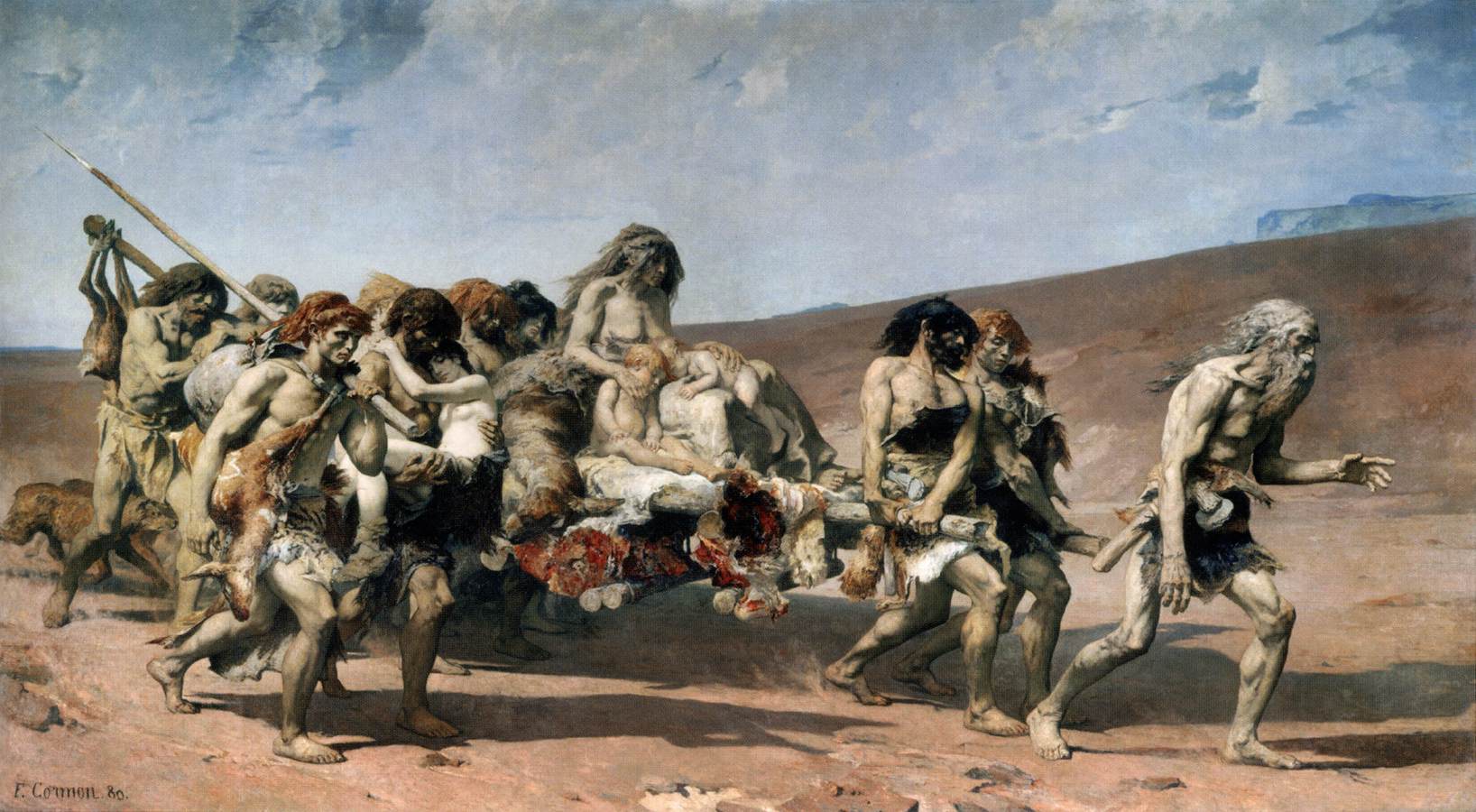
By Patrick Hunt –
Fernand Cormon’s giant 1880 painting almost fills an entire gallery wall at the Musee d’Orsay, Paris, not just because it is almost 23 feet long (7 meters) but also because its dramatic starkness directly strikes the viewer in the often-darkened room. The biblical background of Genesis 4:11-12 is alluded in Cormon’s most known picture: “4:11 And now you are cursed from the ground, which has opened its mouth to receive your brother’s blood from your hand. 4:12 When you till the ground, it will no longer yield to you its strength; you will be a fugitive and a wanderer on the earth.” This story of Cain murdering his brother Abel details some of the narrative of the first homicide in the Bible, occurring ominously within the first few pages of literary human history almost as a foresight of the dysfunctional human family to come. The inspiration Cormon (1845-1924) noted for the vast canvas comes from the first lines of Victor Hugo’s poem, itself developed from the biblical text:
“When with his children clothed in animal skins
Dishevelled, livid, buffeted by the storms
Cain fled from Jehovah,
In the fading light, the grim man came
To the foot of a mountain in a vast plain…”
Victor Hugo, “Conscience”, La Legende des siecles (1859)
The biblical text itself does not specify exactly why Cain killed Abel other than in jealous anger that his sacrifice was unacceptable to God where his brother’s was well received. The rough skins of hunted animals Hugo describes clothing the family of Cain on the “vast plain” landscape are also seen in Cormon’s ekphrasis along with the implied motion of their flight, as Cormon kinetically shows them bent forward by the curse and almost staggering in haste with long strides, heightened in Cain himself. Because Abel’s very blood cried out from the earth, a personification that unlike water does not nurture cultivation, God heard the voice from the violated earth. The much later midrashic gloss of the New Testament in Hebrews 11:4 implies the difference between the two sacrifices was the pride of Cain versus the humble faith of Abel, “a better offering…by faith”. In several ancient societies, the scale of the seriousness of libations poured into the earth moved in importance from water to oil and wine and finally to blood only as a last resort under dire circumstances. There is some hint of transformational power in such libations, especially the latter ones.
It is not lost on the viewer that the biblical curse includes not just the wandering of the fugitive Cain (first described as “a tiller of the earth”, Genesis 4:2) but also the indemnity that reverses his earlier farming success: the ground in the painting is completely arid and devoid of any vegetation; the earth itself denies him its fruit and instead forces him and his family to a carnivorous life. Cain will never be able to stay long enough anywhere to plant, let alone harvest, a crop. Only bloody meat hanging from the carried litter in Cormon’s image, along with hunted game slung over shoulders and the carcasses pendant at the rear just above the hunting dogs, show the source of food that sustains Cain’s family. In some way, the dead animals may echo Cain’s slain brother Abel.
In the manner he has shown Cain and his family, Cormon has also absorbed then-common perceptions of the nascent science of paleoanthropology with Neanderthal and Cro-Magnon archaeological discoveries and the cave dwellers of Lascaux and Abri de La Madeleine across the Dordogne. Cain’s heavy stone axe hanging from his girded waist may also allude to the murder weapon with which he slew his brother Abel. The biblical passage names Cain’s offspring but not his wife and none of Cormon’s dour family of Cain looks even remotely happy. Even the matriarch on the litter, presumably Cain’ s wife in whose lap her grandchildren children slumber from the seemingly perpetual life on the run, has her face darkened in shadow. Such shadows are due not just to the oblique light from the left that deepens all the wanderers’ shadows running before them; they may also be shadows that embody the curse of Cain like the Furies of ancient Greek tragedy who pursued homicide and drove humans mad.
It may be ironic that two of Cormon’s pupils from his Paris atelier are so much more well-known than he is: Vincent Van Gogh and Henri de Toulouse-Lautrec, both of whom studied with him around a year (circa 1882); plus some of Toulouse-Lautrec’s 1880’s changing styles show Cormon’s influence. Cormon’s Cain is haggard and haunted by bloodguilt just as Hugo writes, the fugitive whose “divine mark” as it is often extrapolated from the biblical text may not be visibly obvious: 4:15 “Then the Lord put a mark on Cain so that no one who found him would kill him. ” Cain’s homicidal flight to the Land of Nod east of Eden – Nod is the antithesis of a garden here in the painting – suggests that even the earliest records of human clans maintained taboos against natal family violence and fratricide. The family clan was the first political unit just as Aristotle wrote; if one is not safe within the sacred enclosure of family, one is not safe at all. Cormon’s grim glimpse of human prehistory portends that there was no blissful and innocent Golden Age other than in myth and that humanity would not be celebrating an auspicious beginning.